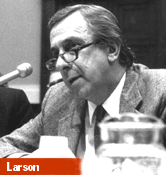
![]()
Commentaries on its purposes and reality from Current
newspaper
 |
|
|
To serve as a catalyst in making our cities work 
When President Clinton had just taken office in 1993, Current asked an assortment of outside-the-Beltway people connected with public broadcasting to write open letters to him about the field's public-service potential. One was Bob Larson, then president of Detroit's public TV station, WTVS, and originator of the local City for Youth outreach project and the national Nitty Gritty City Group. This was originally published Feb. 15, 1993. By Robert F. Larson Mr. President: Your messages to the American people have reflected a fundamental commitment to reconciliation — bridge-building that both creates understanding and celebrates diversity. Please consider the potential of public broadcasting as a means of renewing community in our land. Already, at the beginning of your administration, the treasures of public television were evident in the Washington ceremonies: in the inaugural parade, characters from programs that have so passionately nurtured the minds and spirits of our children; and the magnificent presence of Maya Angelou, who recently graced the national PBS schedule (in "Maya Angelou: Rainbow in the Clouds") to tell a story of healing in the city. Indeed, it is this theme of healing that constitutes the new promise of public broadcasting and takes it beyond the distinguished history of program excellence. For Detroit Public Television, placing the power of telecommunications at the disposal of those who work for the welfare of our city is an imperative. If there is a text for this view of public television as a catalytic agent of change, it is to be found in the prophet Jeremiah's words: "Seek the welfare of the city where I have sent you into exile and pray to the Lord on its behalf. For in its welfare you will find your welfare." We believe that we cannot be public servants or public broadcasters or public citizens without participating in the life of the community we serve, the city whose welfare is our welfare. We hope to enlist your support for a new breed of noncommercial television that, in addition to bringing the best of culture, performance, drama and public affairs, offers its telecommunication strategies and tools to those who are dedicated to making our cities work. We will ask social service agencies and neighborhood groups and religious institutions and schools, "How can we serve you?" and "What can public television do to amplify your activities to change our communities?" We will elect a strategy that has us serving the servants. By working with community-based development organizations that have been effective in improving neighborhoods by building housing, creating jobs and fighting drugs and crime, public television can magnify the commitment and resourcefulness of city residents in helping themselves. The goal is citizen empowerment. Urban communities can be aided and supported by telecommunications when people are connected and begin to hear and listen to one another. We can bring people together in new ways — service provider and potential client, community leader and concerned citizen, neighbor and neighbor, city and suburb. Public television can break through the anonymity of great numbers and transcend neighborhood identity, religious affiliations, social class and race in order to work for the welfare of all. It combines the electronic technologies of teleconferences with old-fashioned town meetings. It is simultaneously high-tech and down-to-earth. It can equip people to help themselves. Seeking the welfare of the nation's cities through telecommunications can have unprecedented impact because of technological advances. New tools for community development become possible — the production and delivery of training materials for city teachers dealing with violence reduction, mobilization of whole cities through teleconferences on youth at-risk, individualized interactive training for the unemployed, special channels for the older American and other special audiences, computer networks for agencies serving the homeless, and new combinations of face-to-face meetings with electronic forums to build new coalitions. This is a new art and a new passion — community problem-solving through telecommunications. In fact, a group of public television stations has agreed to explore what it means to be active participants in the life of their communities in this time of urban decay and resurgent racism. Calling themselves the Nitty Gritty City Group, they have agreed to work with grass-roots organizations and groups, street workers and community activists, with the goal of giving timely and creative attention and access to citizens in their immediate surroundings. Mr. President, please consider utilizing this young, idealistic, accomplished industry for the purposes of national bridge-building and reconciliation, especially in encouraging the solution seekers in our cities. We can work with you in halting the meltdown of our young people or healing the wounds of racism. We can serve as a forum to build a national consensus and conscience. We can serve as a channel for all the voices of America. We can deepen a sense of community locally and nationally. We want to be a part of healing the divisions among us. We want to join you in seeking the welfare of our cities, our nation, and our future. We have no choice but to ask, "Mr. President, how can we serve you?"
Current The biweekly newspaper that covers public broadcasting A service of Current Publishing Committee, Washington, D.C. E-mail to webmaster (202) 463-7055 Copyright 1993 |